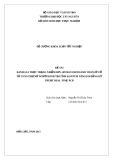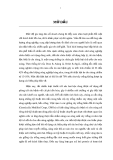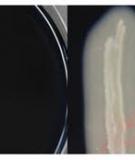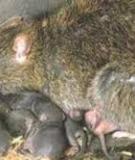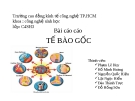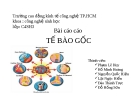Phenotypic and genotypic differentiation in cage populations of Drosophila melanogaster
I. Duration of development, thorax size and weight
F.A. LINTS
M. BOURGOIS
Summary
Oregon-R, a wild type laboratory stock of Drosophila melanogaster, was divided into 3 subpopulations which were submitted to different environmental temperatures. During 6 years, duration of development, thorax size and male wet weight were measured several times in the 3 subpopulations. A genetic divergence between subpopulations was already observed 36 weeks after initiation. That series of experiments confirms the results obtained with Vetukhiv’s subpopulations of Drosophila pseudoobscura. Furthermore it shows that a genetic differentiation between subpo- pulations may arise much faster than had been suspected, even in subpopulations initiated, contrary to the Vetukhiv’s subpopulations, from a population with a narrow genetic base. Different hypotheses, which may explain the origin of the genetic variability present in subpopula- tions derived from a laboratory stock maintained in a constant environment during more than 15 years, are discussed.
Key words : Evolution, genetic divergence, development, Drosophila melanogaster, cage popu-
lations, genetic variability.
Résumé
Laboratoire de Génétique, Université de Louvain, Place Croix du Sud, 2, B-1 348 Louvain-la-Neuve, Belgium
Différenciations phénotypique et génotypique dans des cages à population de Drosophila melanogaster I. Durée de développement, taille thoracique et poids frais
Mots clés : Evolution, divergence génétique, développement, Drosophila melanogaster, cages à
population, variabilité génétique.
Chez Drosophila melanogaster, 3 sous-populations ont été créées à partir de la souche de laboratoire Oregon-R. Ces 3 sous-populations, maintenues à 3 températures différentes, ont été observées à plusieurs reprises durant 6 ans. Les caractères mesurés étaient la durée ûe développe- ment, la taille thoracique et le poids frais. Déjà après 36 semaines, une différenciation génétique entre sous-populations a été observée. Ces observations confirment les résultats obtenus chez Drosophila pseudoobscura, à partir des populations dites de Vetukhiv. De plus, elles montrent qu’une différenciation génétique peut apparaître bien plus vite qu’on ne le pensait et même dans des sous-populations créées, contrairement aux populations de Vetukhiv, à partir d’une population à variabilité génétique réduite. Différentes hypothèses, qui permettraient d’expliquer l’origine d’une variabilité génétique dans des sous-populations créées à partir d’une souche de laboratoire maintenue pendant plus de 15 ans dans un environnement constant, sont passées en revue.
I. Introduction
After a long and almost undisputed reign, neodarwinism, or its successive forms, among which is the modern synthesis theory of evolution, is now being questioned and various aspects of it are becoming rather controversial. GRASSE (1973) and L§vTRuP (1974) emphasized some deficiencies of the theory ; yet nothing very much further came of their criticisms. More recently the ideas of GOULD & ELDREDGE (1977 ; see also ELDREDGE & GOULD, 1972) on punctuated equilibria had much more repercussion, as witnessed by the innumerable letters published by Nature in 1980 and 1981 following HALSTEAD’S (1980) violent criticism of the new exhibition on the evolution of dinosaurs and man in the Natural History Museum in South Kensington. GOULD & ELDREDGE insist on the fact that the idea of punctuated equilibria must be tested on the appropriate paleontological scale. Yet they note that « indirect tests from the genetics of living organisms » can shed some light on the theories of evolution and further emphasize the importance of the relation between the time of isolation and the genetic divergence of different populations.
Whatever the hypotheses which are advanced in order to explain the evolutionary phenomena, they are difficult to test simply because evolution is such a slow-acting process. Numerous studies analyse the end-results brought about by the evolutionary forces ; such are, for instance, the classical studies of CARSON (CARSON & KANESHIRO, 1976) on the Drosophila fauna of the Hawaii islands or of AYALA (AYALA et al., 1975) on the evolution of the Drosophila willistoni group of species. Two approaches differentiate the studies about how that end-result is produced. The first one deals with the effects of natural selection on unique gene differences. Such are the works of L’HERITIER & TEISSIER (1937a and b), the pioneers in population cage techniques, on the competition between the alleles of the Bar and white loci and the elimination of the mutant alleles. Such are also the studies of KALMUS (1945) on the ebony locus, of REED & REED (1948) on the competition between white, miniature, forked mutants and the Muller-5 inversion mutants and of BuzzATi-TRAVERSO (1955) on the Bar and white loci. The second approach tends to mimic natural situations. POWELL (1978) showed the relation between founder-flush cycles and the establishment of premating isolation. Concerning divergence for quantitative traits, the only studies that we are aware of are the 6 papers published under the common title « Genetic divergence in M. Vetukhiv’s experimental populations of Drosophila pseudoobscura » (EH!AN, 1964, 1969 ; MOURAD, 1965 ; ANDERSON, 1966, 1973 ; KrrAGAWA, 1967) and a more recent analysis, also conducted with ’Drosophila pseudoobscura, by MATZKE & DRUGER (1977).
The principle of these experiments was to divide a population of a given origin into a certain number of subpopulations and then submit them to different environments. After a certain time these subpopulations were observed for a series of quantitative traits and an eventual genetic differentiation was searched for. Of course that procedure mimics to some extent the events which are supposed to bring about « geographic speciation » in allopatric populations.
The results of these studies will be discussed later in relation to our own results. Suffice it here to notice that, in the case of Vetukhiv’s populations and with the exception of a not too important observation made one year and a half after the creation of the cages, nothing has been observed before 4 to 5 years after the foundation of the subpopulations. In the case of MATZKE & DRUGER, observations were made for the first time 15 years after the foundation.
We therefore decided to split a wild laboratory population of Drosophila melanogaster into a certain number of subpopulations, to place them in different environments and to observe them for different quantitative traits as soon as possible after the foundation. This was done in order to determine after how much time an eventual genetic differentiation between subpopulations becomes apparent. A second purpose of that series of experiments was to ascertain that the conclusions reached by the team which had been working on Vetukhiv’s cages could be generalized. We report here the results of more than 6 years of observations.
II. Material and Methods
The strain of Drosophila melanogaster used in the present series of experiments is the wild laboratory strain Oregon-R. That strain was maintained in our laboratory at 25 °C for at least 15 years by transferring a hundred flies every third week into fresh half-pint milk bottles. The experiment with the Oregon-R strain started by putting 3 groups of 120 flies in population cages at 21°, 25° and 29 °C, respectively. The number of flies in the 21 ° and 25 °C subpopulations grew rapidly and eventually stabilized at around 1 500 to 2 000 flies per cage. At 29 °C the population quickly died out ; two more unsuccessful attempts were made and, finally, 29 °C was given up. A new subpopulation was then started at 28 °C. After a few weeks and a severe decrease in the number of flies of that 28 °C cage (LINTS & BOURGOTS, 1984) the population eventually expanded and stabilized.
The population cages had a size of 40 x 40 x 20 cms (wooden framework, covered with mosquito net). They contained three 250 ml Erlenmeyer flasks containing 100 ml of the commonly used Drosophila medium and a large quantity of fresh baker’s yeast. Every fifth day at 28 °C, every sixth day at 25 °C and every seventh day at 21 °C, the oldest Erlenmeyer was removed and replaced by a fresh one. After removal, an Erlenmeyer was kept for a week and flies emerging in it were released in the population cage.
The initiation of the Oregon-R subpopulations is designated 1 ; the subsequent experiments are designated A to J ; D! and El refer to experiments made with the offspring of the D and E experimental flies.
The flies needed for a particular experiment were obtained as follows. Watch- glasses were filled with normal medium and some additional yeast. These watchglasses were placed in the population cages for a 2 hour period. The eggs so collected were then redistributed by batches of 10 in 10 x 2.5 cm vials poured with food to a depth of 1.5-2 cm, where the eggs were allowed to develop. Development occurred in a room controlled for temperature and with a photophase of 12 hours followed by a scotophase of 12 hours. Most experiments were done at 25 °C. Experiments B and C were done both at 25° and 28 °C. Experiments E and El were done at 28 °C only.
Duration of development, defined as the time between egg-laying and emergence of the imago, was compiled from the number of emergences recorded every fourth hour during the 12 hour photophase. Thorax size was measured for 50 individuals of each REEVE (1952). The first size sex following the method described by RosExrsort & measurements had brought significant differences between subpopulations to the fore ;
from experiment G on we therefore decided, in order to eventually sharpen our results, to also weigh our flies. Weight was measured with an accuracy of 1/1 000 mg with a Mettler ME22 type balance. Only males were weighed, 24 to 48 hours after emergence, since the weight of the females varies considerably during that period and later on as well, due to development of the ovaries.
III. Results
A. Duration of development
During the 6 years of the experiment the duration of development in the 2 or 3 Oregon subpopulations was measured 9 times, at 25 °C. Figure 1 presents the variations in duration of development of the females during that period. The graph obtained for males is very similar, although, on average, the differences between subpopulations are somewhat smaller. Table 1 gives the level of significance of the differences between subpopulations. It is clear from these data that the divergences between subpopulations appeared very rapidly. The difference between 021 and 025 was not significant in experiment A, made 5 weeks after the foundation, but became highly significant in experiment B, made around 4 months later. On the whole the differences between subpopultions were significant, except at the time of experiment I. It must be noted that the duration of development of the 021 subpopulation is, at 25 °C, shorter than that of the 025 subpopulation, whereas the duration of developpement of flies raised at 21 °C is, of course, appreciably longer than that of flies grown at 25 °C. Besides, the 028 subpopulation, in comparison with the 025 and 021 subpopulations, showed no regular variation in duration of development.
One could suspect that the differences between subpopulations were due, to some extent, to maternal or carry-over effets. Therefore, at the time of experiment D, eggs were collected from the D flies (021 and 025, see fig. 1) which had been, of course, raised at 25 °C. The duration of development of the flies emerging from these eggs (Di generation) was measured at 25 °C. Table 2 shows the duration of development of both the D and D¡ flies. It is clear from these results that the difference between the 021 and 025 subpopulations was not due to maternal or carry-over effects.
Another way of establishing the eventual genetic origin of the divergences observed among the Oregon subpopulations was to cross them and to measure the offspring of these crosses. Such crosses were made at the time of experiments D, E and F and the hybrids studied at 25°, 28° and 25 °C, respectively. The reciprocal hybrids were, of course, raised simultaneously with parental generations. In order to have a basis for comparison a cross was also made between the subpopulation 025 and the wild laboratory strain Bonlez (Belgium), recently caught in the wild and maintained since (for 7 months) in the usual conditions, at 25 °C. Table 3 gives the results of that series of experiments.
It is clear from table 3 that development time did not generally show heterosis in the Fi of the crosses between the 021, 025 and 028 subpopulations, either at 25° or at 28 °C. At the opposite the hybrids obtained by crossing reciprocally the 025 subpopula- tion and the Bonlez strain exhibit a highly significant heterosis.
B. Thorax size
The variation in thorax size during the 6 years of observation showed great similarities with the variation in duration of development. Figure 2 shows these variations for the females. As in the case of duration of development, the graph for males is very similar, yet with smaller differences between subpopulations. Table 4 gives the levels of significance of the differences observed for both males and females.
As for duration of development, the divergence between subpopulations appeared very rapidly (no significant difference in experiment A, significant differences since experi- ment B), yet vanished at the time of experiment I and reappeared in 1985 at the time of experiment J.
Table 5 gives the values for thorax size in the D and D, generations. Here again it may be seen that the difference observed between the 021 and 025 subpopulations was certainly not exclusively due to maternal or carry-over effects : a large part of the divergence observed was thus due to a genetic divergence between subpopulations.
At 25 °C, the thorax size of the 021 subpopulation is larger than that of the 025 subpopulation. Thus, contrary to what happened for duration of development, the difference between the 021 and 025 subpopulations is in the same direction as the environmental effect of temperature on the phenotypic expression of size. As in the case of duration of development, the variations of the thorax size of the 028 subpopula- tion are somewhat erratic.
The Fls obtained by crossing the Oregon subpopulations were also studied for thorax size. The Fls derived from the reciprocal crosses between 025 and Bonlez were also analyzed. Table 6 gives the results of that series of measurements.
In contrast with the results obtained for duration of developpement a significant heterosis could be detected in all cases. It should, however, be noted that the heterosis observed in the Fis of the 025 x Bonlez crosses was noticeably larger than the heterosis of the Fls of the crosses between the Oregon subpopulations.
C. Weight
Weight was measured only during experiments G, H, I and J and, as explained in Material and Methods, for males only. Figure 3 shows the results of that series of measures. The differences between subpopulations are significant in experiments G and H (F!47 = 21.91 *** and F!47 = 8.50 ***), being mostly due to the larger size of 021. In experiment I the differences between subpopulations vanished (F!47 = 1.47 ; n.s.), just as
they did for duration of development and thorax size. In experiment J the differences were again significant (F’ 147 = 8.55 ***). On the whole, the coefficients of the Spearman rank correlation between thorax size and weight are good, both at the interpopulational level (n = 16 ; r = 0.87) and the intrapopulational level (n = 50 ; r varies between 0.50 and 0.80).
IV. Discussion
Three quantitative traits, duration of development, thorax size and wet weight, were measured at more or less regular intervals over a six year period in subpopula- tions of the Oregon-R wild laboratory strain of Drosophila melanogaster raised in cage populations at 21°, 25° and 28 °C. The very same experimental protocol was used in each experiment. Yet there are relatively large variations from one experiment to the other. In this respect it is important to emphasize the fact that these variations are almost identical as well for the 3 experimental subpopulations as for the control wild strain. These variations are therefore surely not due to genetic variations. Furthermore, we dot not think that these differences should be attributed to some minor changes in the controlled environment of the fly-room. Indeed, for the last three years, we have
an experiment in progress, in which, every month, the life span of 400 flies (200 at 25 °C, 200 at 21 °C) is recorded in conditions which are, of course, strictly identical from one month to the other. Yet from one observation to the other we observed variations, the amplitude of which equals 60 p. 100. Although we looked at many possible reasons for these variations we still do not know what the factor controlling them could be. Its existence must, however, be taken into account when comparisons are made between experiments conducted at different times (LINTS et al., in prep.).
When subpopulations are compared, significant differences appeared very early, i.e. only 20 weeks after isolation (021 and 025), for duration of development as well as for thorax size. A first observation made 5 weeks after isolation disclosed no difference. Concerning weight the differences were present at the first observation which was, however, only made 36 weeks after the beginning of the experiment.
These results confirm the conclusions of the several authors who worked with Vetukhiv’s populations. Furthermore, they show that differentiation may arise much earlier than it had been suspected. Indeed, observations on Vetukhiv’s cages started only 4 years and 5 months after isolation (EaxMnrr, 1964) with the exception of an observation made on wing length by Art!ExsoN (1966) when the subpopulations were 18 months old and which disclosed no interpopulational differences. The fact that the differentiation of our Oregon subpopulations appeared so rapidly is even more surpris- ing when one considers the respective origins of the Oregon and of Vetukhiv’s subpopulations. Indeed, our subpopulations were started from a wild laboratory popula- tion which had been kept for at least 10 years in a constant environment, at 25 °C, and could thus be supposed to possess a somewhat reduced genetic variability. On the contrary, Vetukhiv’s cages, « in order to provide the populations with as much genetic variability as possible to give selection material to work on » (EHRMnN, 1964), were started from founders which were hybrids from more than 40 different strains. It may thus be concluded that in populations submitted for a long period - at least more than 100 generations - to very stable environmental conditions, either there remains an important amount of genetic variability, or there exist large possibilities of rapidly creating new genetic variability.
When tested in a single environment, the phenotypic differentiation between subpopulations which were exposed to different environmental temperatures - this is specially true for 021 and 025 - does not necessarily mimic the phenotypic variation brought about by different environmental temperatures. Indeed, when tested at 25 °C, the 021 flies are larger than the 025 flies, but at the same temperature, the duration of development of the 021 flies is shorter than that of the 025 flies. This is an interesting result since it confirms similar and unexplained results of Arr!Exsorr (1966) for wing length and for weight - two traits comparable to thorax size -, of MATZKE & DRUGER (1977) for thorax size and of ANDERSON (1966) for duration of development.
The phenotypic differentiation observed between our subpopulations and particu- larly between 021 and 025 is not due to carry-over effects. It is thus due, at least partly, to a genetic differentiation between lines. This is further demonstrated by the fact that a significant heterosis for thorax size is apparent when the 3 subpopulations 021, 025 and 028 are reciprocally crossed. Curiously enough, in the same conditions, no heterosis could be detected for duration of development. Body size is largely under the control of polygenes with additive action (ROBERTSON & REEVE, 1952 ; LINTS & GRUWEZ, 1972), while duration of development does not depend on such genes (LINTS & GRUWEZ, 1972).
The somewhat erratic variations of the 028 subpopulation deserve some comments. They could be due to the fact that 28 °C is too high a temperature for Drosophila melanogaster, as shown by the failure of all the attempts made to create a subpopula- tion at 29 °C. They could also be due to the origin of that 028 subpopulation which, presumably due to maladjustment to the temperature, suffered a severe bottleneck and therefore started from as few as half a dozen individuals (for further details, see LINTS & BOURGOIS, 1984). On the other hand - and this is the only comparison which can be made with other studies - six years after the foundation of Vetukhiv’s cages, raised at 19°, 25° and 27 °C, ANDERSON (1966) did observe that the wing length of the flies raised at 19 °C was larger than that of the flies raised at 25 ° and 27 °C, but he could not detect any difference between the 25° and 27 °C flies. After 12 years, however, (ANDERSON, 1973) the difference between the 19 °C flies and the other temperature flies was still present, while the 25 °C flies were larger than the 27 °C ones. Continuing observations must be made in our populations.
Subpopulations started from a single population, raised for a long time in a constant environment, and which are submitted to different ecological conditions may thus very rapidly exhibit phenotypic differentiation which is, at least partly, due to genetic differentiation. Whether the genetic variability necessary for differentiation was present in the strain at the foundation of the subpopulations or arose de novo after these subpopulations were put in their new environment is a question for which we still have no definite answer.
One has probably to consider both origins as plausible. One knows indeed that old laboratory stocks (e.g. Oregon-R) are not homozygous at all loci, i.e. the mild inbreeding to which they are submitted does not exhaust genetic variability and some variability remains balanced for a long time. There are, however, some difficulties to admit that the extremely rapid differentiation observed arose 3 or 4 generations after foundation solely by the classically postulated mechanism of natural selection acting on isolated breeding populations. It therefore appears to us that it is not forbidden to speculate about the origin of some new genetic variability.
YOUNG (1979) has shown that 2 laboratory strains of Drosophila melanogaster, isolated for at least 50 years, differed sensibly in the chromosomal location of the repeated elements of the middle repetitive DNA. ANAVIEV et al. (1978) studied 2 cloned Drosophila melanogaster DNA fragments present in the genome in hundreds of copies. These fragments contain genes whose transcription yields abundantly 2 classes of mRNA. The sites of localization could be detected. The authors found small but significant differences in the number and localization of the sites among individuals of the same stock, whereas they could show that different stocks differed utterly. On their side ZUKER & LODISH (1981) in Dictyostelium discoideum have clearly shown that some repetitive sequences are linked to a set of developmentally regulated mRNAs. Of course this immediately suggests that these repetitive sequences may play an important role in the developmental program of Dictyostelium and, eventually, of other organisms as well. That demonstration of ZUKER & LoDisH confirms the views of BRMEN & DAVIDSON (1969 ; see also DAVIDSON & BRITTEN, 1979) who postulated that the association of specific repetitive sequences with single copy DNA may be involved in the coordinate control of sets of functionally related genes during development and differentiation.
Can it then in the present case not be speculated that the rapid genetic divergence observed between our subpopulations could be due to the action of transposable elements, transposition of which could occur in a cataclysmic way as a result of the
transfer to new ecological conditions ? That suggestion is in agreement with the conclusions reached by RosE & DOOLITTLE (1983) in a review of the molecular biological mechanisms of speciation : « Transposable elements are potentially important for the phyletic, i.e. within species, evolution of both mendelian and asexual popula- tions ». That suggestion is not at variance with a more cautious statement of DAVIDSON & POSAKONY (1982) who said that « despite their ubiquity, their quantitative promi- nence, their apparent developmental regulation and the amount of interest they have aroused, the repetitive sequence transcripts of animal cells remain a phenomenon in search of a physiological meaning ».
Received August 26, 1985. Accepted October 22, 1986.
References
ANAVIEV E.V., GVOZDEV U.A., ILYIN Y.V., TCHUR1KOV N.A., GEORGIEV G.P., 1978. Reiterated genes with varying location in intercalary heterochromatin regions of Drosophila melanogaster polytene chromosomes. Chromosoma, 70, 1-17.
phila pseudoobscura. 3. Divergence in body size. Genet. Res., 7, 255-266.
ANDERSON W.W., 1966. Genetic divergence in M. Vetukhiv’s experimental populations of Droso-
Drosophila pseudoobscura kept at different temperatures. Evolution, 27, 278-284.
AYALA F.J., TRACEY M.L., HEDGECOCK D., RICHMOND R.C., 1975. Genetic differentiation during
the speciation process in Drosophila. Evolution, 28, 576-592.
ANDERSON W.W., 1973. Genetic divergence in body size among experimental populations of
165, 349-357.
BUZZATI-TRAVERso A.A., 1955. Evolutionary changes in components of fitness and other polygenic
traits in Drosophila melanogaster populations. Heredity, 9, 153-185.
CARSON H.L., KANESItIRO K.Y., 1976. Drosophila of Hawaii : systematics and ecological genetics.
Ann. Rev. Ec. Syst., 7, 311-345.
BRITTEN R.J., DAVIDSON E.H., 1969. Gene regulation for higher cells : a theory. Science, N.Y.,
Gembloux, Gembloux, Belgique.
DAVIDSON E.H., BRITTEN R.J., 1979. Regulation of gene expression : possible role of repetitive
DAGNELIE P., 1975. Theorie et méthodes statistiques. 463 pp., Les Presses Agronomiques de
297, 633-635.
sequences. Science, N.Y., 204, 1052-1059. DAVIDSON E.H., POSAKONY J.W., 1982. Repetitive sequence transcripts in development. Nature,
pseudoobscura. 1. Rudiments of sexual isolation. Genet. Res., 5, 150-157.
EHRMAN L., 1964. Genetic divergence in M. Vetukhiv’s experimental populations of Drosophila
ELDREDGE N., GOULD S.J., 1972. Punctuated equilibria : an alternative to phyletic gradualism. In : SCHOPF T.J.M. (ed.), Models in Paleobiology, 82-115. Freeman, Cooper and Co, San Fran- cisco, California.
CrouLD S.J., ELDREIbGE N., 1977. Punctuated equilibria : the tempo and mode of evolution
reconsidered. Paleabiology, 3, 115-151.
GRASSE P.P., 1973. L’evolution du vivant. 477 pp., Albin Michel, Paris. HALSTEAD L.B., 1980. Museum of errors. Nature, 288, 208. KALMUS H., 1945. Adaptive and selective responses of a population of Drosophila melanogaster containing e and e+ to differences in temperature, humidity and to selection for developmen- tal speed. J. Genet., 47, 58-63.
KITAGAWA 0., 1967. Genetic divergence in M. Vetukhiv’s experimental populations of Drosophila
pseudoobscura. 4. Relative viability. Genet. Res., 10, 303-312.
EHRMAN L., 1969. Genetic divergence in M. Vetukhiv’s experimental populations of Drosophila pseudoobscura. 5. A further study of rudiments of sexual isolation. Amer. Midland Natur., 82, 272-276.
Drosophiles « Bar ». C. R. Soc. Biol., 124, 880-882.
L’HExiTiEx P., TEISSIER G., 1937a. Elimination des formes mutantes de Drosophiles. Cas des
Drosophiles « ebony o. C. R. Soc. Biol., 124, 882-884.
L’HERITIER P., TEISSIER G., 1937b. Elimination des formes mutantes de Drosophiles. Cas des
melanogaster ? Mech. Age Dev., 1, 285-297.
LINTS F.A., GRUWEZ G., 1972. What determines the duration of development in Drosophila
populations of Drosophila melanogaster. Genet., Select., Evol., 16, 45-56.
LINTS F.A., BOURGOIS M., 1984. Population crash, population flush and genetic variability in cage
L!VTRUP S., 1974. Epigenetics. 547 pp., John Wiley and Sons, London. MATZKE M.A., DRUGER M., 1977. Evolutionary divergence between two populations of Drosophila
pseudoobscura. Evolution, 31, 597-602.
phila pseudoobscura. 2. Longevity. Genet. Res., 6, 139-146.
MOURAD A.E.K., 1965. Genetic divergence in M. Vetukhiv’s experimental populations of Droso-
32, 465-474.
POWELL J.R., 1978. The founder-flush speciation theory : an experimental approach. Evolution,
tion, 2, 176-186.
REED S.C., REED E.W., 1948. Natural selection in laboratory populations of Drosophila. Evolu-
220, 157-162.
ROBERTSON F.W., REEVE E.C.R., 1952. Studies in quantitative inheritance. 1. The effects of selection of wing and thorax length in Drosophila melanogaster. J. Genet., 50, 414-448. RosE M.R., DOOLrrTLE W.F., 1983. Molecular biological mechanisms of speciation. Science, N.Y.,
YOUNG M.W., 1979. Middle repetitive DNA : a fluid component of the Drosophila genome. Proc. Natl Acad. Sci., USA, 76, 6274-6278.
ZUKER C., LODISH H.F., 1981. Repetitive DNA sequences cotranscribed with developmentally regulated Dictyostelium discoideum mRNAs. Proc. Natl Acad. Sci., USA, 78, 5386-5390.




